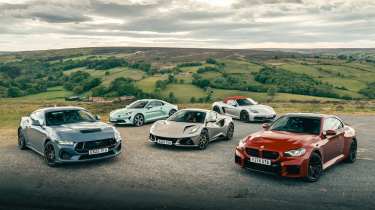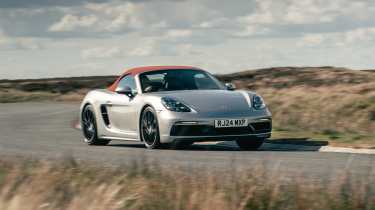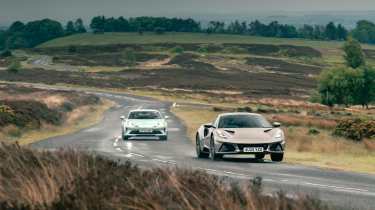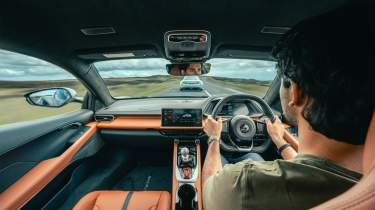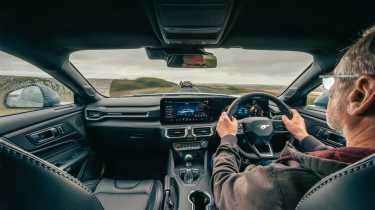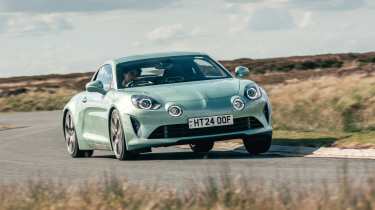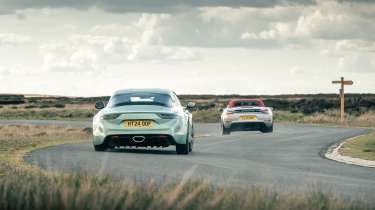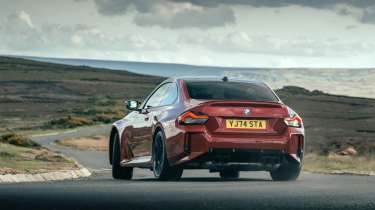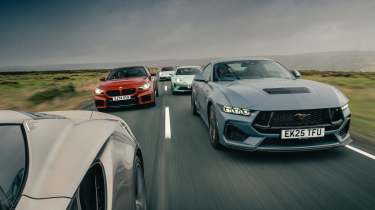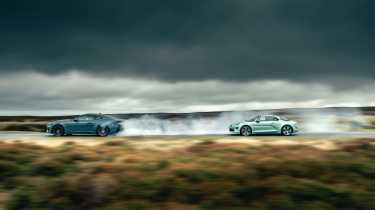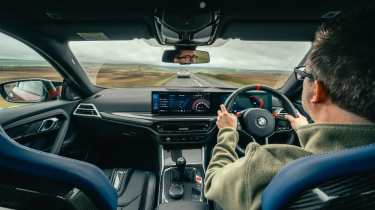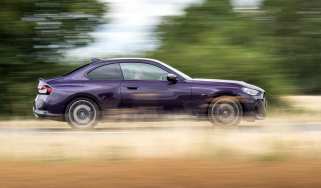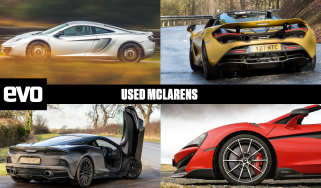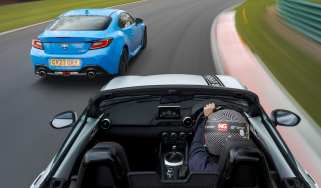BMW M2 v Porsche Boxster GTS v Lotus Emira v Alpine A110 v Ford Mustang GT
It’s been the sports car class leader for over two decades, but can rivals from Alpine, BMW, Ford and Lotus finally take the lead over Porsche’s Boxster?
You may remember in evo’s February 2024 issue we got together almost every hot hatch on sale in the UK for one big summit-meeting test. There were 18 cars (sales of Audi’s S3 and RS3 were temporarily paused to make way for the arrival of facelifted versions, so call it 20 in spirit). Today, in mid-2025, that same test would include in the region of 13 cars.
What we have here is a similar test for sports cars: a cross-section of the market in one place at one time. The picture isn’t quite as pessimistic as the five cars you see gathered here: whereas our hot hatch test took in nearly every ICE and hybrid variant on the market, this test concentrates on the sports car world’s heartland middle-ground. In the lowlands, Mazda’s evergreen and ever-brilliant MX-5 still abides (though it’s less affordable than it once was, starting from £28,285). At the niche end Caterham and Morgan and smaller cottage-industry firms are still creating captivating cars. And at the higher end, there’s certainly no shortage of supercars and super-GTs.
But in the more mainstream middle, it’s a pretty compact cross-section. The Toyota Supra is no longer on sale in the UK, though its soft-top BMW Z4 cousin continues. Toyota’s brilliant GR86 has likewise gone, cut off in its prime by a combination of ADAS, emissions and other regulatory bear-traps. Just as pure EVs were omitted from the hot hatch test, so too we’ve decided not to include the MG Cyberster here.
We’ll drive the cars that are here back-to-back, reflect on the sports car market as it stands, and choose the best – it is a group test, after all. It would have been a group test of fixed-head coupes but Porsche was temporarily without a non-GT-department six-cylinder 718 Cayman on its test fleet, so our Fast Fleet 718 Boxster GTS long-termer gamely leapt off the subs bench to take part – and provide a flat-six foil to the V6 Lotus Emira, with a near-400bhp power output.
I’m heading north in the Boxster to join the others at our test base camp in North Yorkshire. It’s a topical car to be in, Porsche having recently ceased production of both the 718 Boxster and Cayman. Of course, the biggest difference compared with the Cayman coupe is the motorised fabric roof. Otherwise, same platform, same interior, same powertrain choices, same model range. Same claimed kerb weight, too. When the 718 was still on sale, all Boxsters were priced at £2000 more than their equivalent Cayman, however. The 718 range started from £53,800 for the base 2-litre flat-four turbo with 296bhp, spanning £63,800 for the 345bhp 2.5-litre S, up to £75,300 for the naturally aspirated 394bhp 4-litre GTS.
Porsche, of course, makes another fairly well-established sports car model. We strongly considered putting the newly released Porsche 911 Carrera T into this test: it’s the purest driving experience in the ‘regular’ 911 line-up and the only non-GT3 version available with a manual gearbox. It is also very much a sports car as opposed to a supercar or a GT. But it costs £115,000. Even the base, auto-only Carrera now tops £100k. The 911 range is now at the six-figure hinterland where sports car pricing blurs into that of GTs and supercars.
Naturally, there’s a bit more road and wind noise in the Boxster than a Cayman (in fact, as this car has racked up more miles on our long-term fleet, once discreet creaking noises from the roof are becoming more vocal on bumpy roads). And there is slightly less torsional rigidity than in the coupe too, manifesting itself in slightly less precise steering and body control. But there’s such inherent precision in the 718 to start with that the Boxster is still head and shoulders above most cars on sale today. Leaving the motorway and striking out across the countryside is a reminder of its sheer poise. And the consistency of its responses: it always reacts to a bump, crest or compression in the same way. Its handling has a lovely neutral balance, without a surfeit of understeer, and a smooth transition into mild oversteer.
You feel you always have time to respond and react to whatever the road throws at you. And its soaring flat-six powerplant is endlessly inspiring. It’s a big engine for a small car but somehow it doesn’t feel inappropriate in the Boxster, which has the dynamic bandwidth to absorb the extra power and weight.
Pulling into our moors meeting point, there’s one car already waiting, driven up to the test by senior staff writer Yousuf Ashraf: the Lotus Emira. It looks fantastic to my eyes: a real junior supercar. As well it should given that it’s the most expensive car in this test. When the Emira launched, back in 2022, the V6 First Edition special was priced at £76,000 and the deferred 2-litre, four-cylinder turbocharged AMG-engined ‘i4’ version was planned to start below £60k.
This example is a V6 Base Edition, employing the Toyota-sourced, Lotus-modified, supercharged 3.5-litre with 400bhp, and its price is a bracing £96,500 (Lotus has since launched a V6 SE derivative with a number of upgrades but the same list price). The four-cylinder starts at £79,500 for the base Emira Turbo with 360bhp, and £89,500 for the 400bhp Turbo SE.
The V6 is available with a six-speed manual gearbox, as tested here, or a six-speed torque-converter auto, and the four-cylinder only with an eight-speed dual-clutch transmission. There are two suspension options: softer Touring or firmer Sport; this is the former, paired with all-rounder Goodyear Eagle F1 SuperSport tyres (racier Michelin Cup 2s are an option).
Subjectively, the roofline is perhaps a little high, but otherwise I think the Emira has real exotic visual impact. Each of the other cars have their own singular appeal, however: we’re shortly joined by editor-at-large John Barker in the small but svelte Alpine A110, hired hand Tom Barnard in the rumbling V8-powered Ford Mustang GT, and contributing writer Antony Ingram in the most powerful car of the test, the recently updated BMW M2. While photographer Aston Parrott enlists them to help clean the cars before pictures start in earnest, I slink off in the already sparkling Lotus (thanks, Yousuf) to refamiliarise myself.
Settling into the cabin, all the excitement around the Emira’s reveal comes flooding back. Here was a Lotus that promised vastly improved quality and ergonomics, had an overflowing order book following its debut at the 2021 Goodwood Festival of Speed, and – it seemed – financial stability to build upon following Geely’s takeover.
This is my first time back in an Emira since driving pre-production cars in 2022. They carried huge appeal but also some niggling drawbacks, many of which Lotus said would be rectified on the final production car. It wasn’t until last year that evo finally had chance to drive a customer-representative Emira, a 2-litre model that still impressed despite still suffering from a few niggles.
For me, the interior looks as good as the exterior, and the quality is thoroughly impressive. The seats look fantastic, the upholstery feels top-notch, there are plenty of places to put things and the touchscreen interface has all the functions you’d expect of a high-end premium car. That said, while the white-on-black text looks smart and minimal, it isn’t particularly legible on the move, and the response is a touch laggy. Just skipping a music track or radio station is a trickier process than it should be.
There are a few ergonomic gripes, too: I feel like I’m sitting on the plump seat rather than in it; the headrest protrudes into the back of my head; I can’t quite position the steering wheel where I want it; the pedals are offset toward the centre of the car and very close together. I’m wearing size nine trainers and occasionally catch my left shoe’s edge against my right while pressing the clutch and brake pedals. There’s a lot of ‘jump-in’ on the brake pedal: a disconcerting dead zone at the top of its travel, beyond which there’s a sharp bite that can be tricky to modulate. Likewise the throttle response. It’s easy to under- or over-blip while downshifting. That’s an activity that needs patience: the six-speed manual is a little balky and doesn’t like to be rushed.
The switchgear (some of it sourced from Volvo) is neatly integrated, although the steering wheel controls necessitate chunky spokes that make it awkward to fit your hands around fully. This might contribute to a slight sense of vagueness on the move. The steering wheel itself writhes in your hands and the front wheels tug around eagerly over cambers, but despite all the feedback it takes a while to get a clear picture of what the front tyres are up to.
Once you trust it, however, the Emira is a remarkably stable car. These roads are challenging: steep climbs, weightless crests, mid-corner bumps, corrugated braking zones. The Emira isn’t an ultimate benchmark for precision, but it does have real elements of magic, particularly ‘in heave’, where the car rises on its suspension over crests. It’s superbly controlled over brows and yumps. There’s enormous traction, too, even with the stability systems switched off, and when they are active, they intervene so subtly you barely know they’re there.
Every time you open and shut the throttle with intent, you can see the supercharger actuator in action in the mirror. The V6 sounds better on the outside than the inside, though; there’s a serrated rasp to the Emira’s exhaust note, which sounds evocative drifting across the moorland, but it’s a slightly thrashier soundtrack from inside the car. Still, it’s an engine with the firepower to push the Emira to a 180mph top speed.
Lotus had announced that the Emira would end production in 2026, to be replaced with an electric sports car. However, the brand’s repositioning as an EV specialist offering saloons and SUVs has struggled to gain momentum, with slow sales resulting in the Eletre and Emeya being re-engineered to take plug-in hybrid powertrains. The Emira therefore accounted for more than 5000 of Lotus’s 12,000 sales in 2024 (a noteworthy increase on the 1710 cars it sold in 2021, the final year of Elise, Exige and Evora production).
New Emira trim levels have been introduced, including the SE version mentioned previously, with revised steering geometry, which based on this test could be exactly what it needs. The model’s lifespan is likely to extend: MD Matt Windle has even suggested that hybrid power could be incorporated into the Emira and that an open Spider version may be introduced in the future.
Like Lotus, Alpine is going through an electric rebrand. An all-new, fully electric A110 is scheduled to launch in the first half of 2026. (Indeed, both companies were initially collaborating on the car as a joint project before parting ways in 2023.) There’s a far bit of Lotus in the existing A110 too, given it began life as a joint venture with Caterham, which itself recruited numerous ex-Lotus engineers to work upon it.
In fact, in some ways it’s a more traditional Lotus than the Emira: smaller, lighter, more modestly powered. Swing the door closed via its endearingly flimsy-feeling leather strap and it feels so light, and the cabin so small, with fabulous bucket seats trimmed like a vintage leather jacket. It’s like a classic car made modern, and not only in terms of its styling.
Apart from its special Ash Green (or Vert Cendre) paint, a £4675 option limited to 110 cars, this is a base-spec A110: the lowest power output of 249bhp, and lowest price of the range at £55,160. Above it there’s the 296bhp, £69,890 GTS and the high-carbon-content £106,490 R. For many, this cheapest Alpine is also the most enjoyable. Its light weight enables relatively soft suspension and it gets down the road in a uniquely fluid way.
‘It reminds me of what a Lotus should feel like more than the Emira does,’ says Elise-owning Yousuf. ‘It’s so fluid and satisfying, you barely need to put any effort in to make progress and enjoy it. The level of performance feels just right.’
‘I would put money on this one being stiffer than the first edition of this car,’ John muses. ‘It has a little more edge to it, which overall I think I prefer because it gives you more feel at the steering. The major issue I had with the original was that in the wet there was so little steering feel you weren’t sure whether it was understeering. There’s still a lot of magic in the way this car covers the ground, particularly difficult roads like these.’
The engine is perhaps the weakest link; the 1.8-litre turbo four is a lightweight unit with an excellent specific output but it sounds a bit like a hairdryer when it’s idling and not particularly evocative when you’re pressing on, though you can hear little huffs and puffs from the turbo (and cartoonish pops and crackles from the exhaust). The A110 is deceptively fast in a straight line, mind. Thank the small frontal area and light weight (1102kg) for that.
Interestingly, considering the manual gearbox is as endangered a species as the sports car, this is the only car in this test without three pedals and a lever, since it was designed from the outset around its seven-speed dual-clutch transmission. I can’t help but wonder how the A110 would feel with a gearlever in the middle of its cabin instead of its spar-like centre console, but Yousuf and Antony are happy with the paddleshift: ‘I thought I would miss a manual but I quickly forgot about it,’ Yousuf says. ‘You can keep both hands on the wheel and settle into a rhythm.’ Antony agrees: ‘I barely noticed it wasn’t a manual. It just doesn’t harm the experience.’
Depending how you drive the softly suspended Alpine, it can settle into default safe-ish, steady-state understeer, or it can be manipulated into attitude with weight transfer. The downside is that, unlike the Lotus, which is spookily calm over crests, the Alpine can get unsettled by compound undulations and begin to tie itself in knots if you’re going quickly on a fast, dipping road.
Nonetheless, it’s a deeply likeable car. ‘It’s so compact that you never worry about placing it,’ says Antony. ‘There’s so much more room to play with, and it’s still a pleasure when the road gets narrow.’
Back at base, everyone is a bit nonplussed by the Emira’s steering. Yousuf finds it fidgety and alive when you’re driving in a straight line, yet once the tyres are loaded up in a corner it loses its feel and weighting, a sentiment John echoes. Antony finds the steering exaggeratedly jittery over lumps and cambers, and in that vein Tom compares it to an old Land Rover, which is possibly not what Lotus was going for. He’s enamoured with the Emira’s design, however, and John too: ‘It looks fantastic. When you see one on the road it really does like look like a miniature supercar. It’s a sort of cut-price, scale model of a Ferrari.’
The jury is slightly less keen on the M2’s visuals. ‘The boxy arches are good but the whole thing looks like it’s been wrapped with the camo still fitted,’ is John’s understatedly brutal assessment. BMW has remained a roadster and coupe market mainstay with the aforementioned Z4 from £47,000, and the £50,000, 3-litre, 369bhp M240i xDrive two-door coupe. We’ve chosen to include the M2 in this test, not least because the M division’s smallest model has recently been updated – even if it does blur the lines between sports car and sawn-off sports saloon.
The 2025 version has had an increase in power from 454bhp to 473bhp, gets BMW’s latest OS 8.5 software for its enormous curved touchscreen, and has some new wheel and colour options, including this car’s Fire Red paintwork. Price has increased slightly, to £68,795. This car also has a few options, including the £9500 Track Package, which includes a carbon roof (previously standard), top speed lifted to 160mph, carbon interior trim and the love-them/loathe-them M carbon bucket seats.
Just as the M2 is built on a shortened variation of the current 3- and 4-series platform and adopts the same track width and suspension architecture as the M3 and M4, it also uses a version of those cars’ S58 twin-turbo straight-six. It’s such a brawny engine: the M2 feels dramatically faster than any other car here.
Although the manual shift (a £1925 option) is not the most tactile in the world, and annoyingly the optional bucket seats’ carbon leg divider catches your leg as you press the clutch pedal, it does bring an extra layer of interactivity. You’re more inclined to stay in one gear for longer, feeling the engine at work at different stages of its rev range. The torque curve is very flat, from 2650rpm all the way to 6130rpm (a little higher than in the pre-’25 car), making it easy to dip in and out of the mighty performance on offer. Even in higher gears, it’s possible to adjust the car’s attitude with the throttle. I have a really enjoyable drive, savouring the M2’s relatively neutral balance, oodles of torque and excellent composure over yumps and crests.
‘It completely ignores the poor surfaces that had the Lotus pulling to and fro,’ Ant notes, ‘though it also doesn’t send a great deal of info back to your fingertips, so it’s swings and roundabouts there.’ John and Yousuf likewise feel the steering lacks a sense of on-centre connection.
As with every modern M car, there are endless modes for drivetrain and dampers alike. John and I both find the M2’s ride and handling feels better resolved than that of the early production car we group-tested back in evo 312, but it’s still a car lacking the final few degrees of communication to really feel at one with. ‘It doesn’t give me confidence to really lean on it through fast corners or in the wet,’ Yousuf notes. ‘It does grip well, but finding the limit feels like a step into the unknown at times. It’s happier on twisty, tighter sections of road, where you can explore its balance. Then you realise how friendly and playful it can be – it’s the hooligan of the test.’
The BMW’s closest competitor here in ethos is the Ford Mustang. While the range-topping £68k, 447bhp Dark Horse featured in last year’s evo Car of the Year test, we’ve chosen to focus this time on the regular £58,470, 440bhp Mustang GT. There’s no longer an EcoBoost variant in the UK, so even entry-level Mustang ownership includes a V8. You can choose from manual or auto, coupe or convertible, the latter of each costing an extra £2000 and £3500 respectively. With leather/vinyl Recaros, MagneRide dampers, Vapour Blue paint and bronze-coloured trim, this GT is £64,120 as tested.
Unlike the Dark Horse on eCoty, it’s thankfully not saddled with the frustrating ten-speed auto. The manual GT doesn’t get the satisfyingly tactile Tremec gearbox of the Dark Horse, but its regular six-speed ’box is still great, enabling you to change gear about as quickly as you can move your hand. The V8 idles with a lovely smooth burble, and there are switchable exhaust modes via myriad touchscreen menus.
As with the M2, the Ford’s interior is dominated by glossy digital screens. For me, that means losing some of the character that typified the previous-gen Mustang, but it does bring its cabin into line with modern customer demands. As in the older Mustang Mach 1, you can customise ancillary gauges on the screen with dizzyingly detailed information: cylinder head temperature, air-to-fuel ratio and much more besides. There’s a plethora of driving modes, too, including Track and Drag Strip, and Line Lock, to assist burnouts.
Despite having nearly as much torque as the M2, it feels restricted in its delivery, particularly in the low gears. ‘It almost feels like Ford is saving Mustang buyers from themselves,’ Ant ponders. The result is a car that feels slightly lethargic: quick enough, but not terribly eager.
It handles well, if less nimbly than the other cars here, and is less composed over crests. There’s a boat-like feel to the Mustang: it sits down at the rear under acceleration and the big bonnet lifts ahead of you. Climbing steep hills, you occasionally need to sit up in the seat to see past the nose, since there’s so much bonnet ahead of you. The MagneRide dampers’ firmest setting is a little harsh for these roads; Sport is the sweet spot. The Mustang is more a momentum car than point-and-squirt, and you can carry good speed. It’s fun alright.
Yousuf’s a fan: ‘It’s approachable and surefooted; nowhere near as agile or as playful as the M2, but the controls feel more reassuring to me and I’m more at ease driving it quickly. The Mustang’s ultimately a less capable car with more to manage, but a more satisfying one for me overall.’
Once we’ve cast our votes and totted up the scores, it’s a surprise to see the Mustang tie with the BMW for fourth place. Despite being the baby M car, the M2 is a little too wide and remote to fully gel with all judges. ‘It’s a little more like the Mustang than it probably wants to be,’ JB notes, sagely. The Lotus takes third. It’s a car we all want to like, and would love to spend more time getting to know, and it feels like it still has more potential to unlock – but in this spec it’s not as polished nor communicative as we’d expect of a Lotus sports car.
It’s a much closer run thing between the Alpine and the Porsche. Antony considers the A110 his favourite car on sale today, and this eight years after launch. ‘I’m not convinced anyone will ever build a better semi-accessible sports car,’ he says. We’re all more charmed by the Alpine’s light-touch character than the more sober Porsche, but the Boxster is just so darn good. ‘It’s really hard to fault,’ Yousuf concedes. ‘It’s such a rounded package and makes you wonder how Porsche has pulled it off with what is essentially a 13-year-old platform.
‘It has the best sounding engine here, the gearshift is sweet and the chassis feels more poised and less busy than the Emira’s. It’s everything you expect a sports car to be. The Alpine is more distinctive to drive: it genuinely doesn’t feel like anything else and that keeps me wanting to come back to experience it once more. The Boxster is more conventional – but still brilliant.’
And if this 718 were a Cayman, it would have even more precision and poise. It takes victory just as it goes off sale. A110 sales are currently scheduled to end in Q1 2026, while this current M2 has a couple of years to run, so too the Mustang. Given how much of the previous, sixth-generation Mustang’s hardpoints and hardware remain in this Mk7 car, you sense Ford isn’t at liberty to invest heavily in a brand-new pony car.
The sports car market has shrunk for well-established reasons: the needs of manufacturers to invest in electric and electrified models; shifts in consumer tastes and greater levels of performance from more ordinary cars; prices that have increased beyond what many are prepared to pay; emissions and safety-related legislative costs making current platforms obsolete without the capital to invest in replacements; and sundry factors besides.
If we were to run this test again a year or two from now, there would likely be just three cars present: the M2, the Mustang and – against the odds – the Emira. Or perhaps five, with an electric Alpine and an electric Porsche too, although no reveal date has been announced for the Boxster/Cayman’s battery-powered successor. Meanwhile, in petrol GTS guise, the Porsche 718 is still 2025's best sports car – and the Alpine A110 a truly enthralling alternative now that the Porsche is no longer in production.
